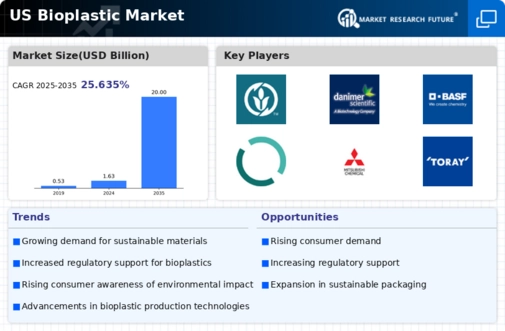Rising Environmental Awareness
The increasing awareness of environmental issues among consumers is a pivotal driver for the bioplastic packaging market. As individuals become more conscious of the ecological impact of traditional plastics, they are actively seeking alternatives that align with their values. This shift in consumer behavior is reflected in market data, indicating that approximately 70% of consumers in the US prefer products with sustainable packaging. Consequently, companies are compelled to innovate and adopt bioplastic solutions to meet this growing demand. The bioplastic packaging market is thus experiencing a surge in interest, as brands strive to enhance their sustainability profiles and appeal to eco-conscious consumers.
Government Regulations and Policies
Government regulations and policies aimed at reducing plastic waste are playing a crucial role in shaping the bioplastic packaging market. Legislative measures, such as bans on single-use plastics and incentives for sustainable packaging, are encouraging manufacturers to explore bioplastic options. In the US, various states have implemented regulations that promote the use of biodegradable materials, thereby creating a favorable environment for the bioplastic packaging market. These regulatory frameworks not only stimulate demand but also provide a competitive edge to companies that prioritize sustainable packaging solutions.
Corporate Sustainability Initiatives
Many corporations are adopting sustainability initiatives as part of their corporate social responsibility strategies, which is driving the bioplastic packaging market. Companies are increasingly recognizing the importance of sustainable practices in their operations, leading to a shift towards bioplastic packaging solutions. This trend is evident in the food and beverage sector, where major brands are committing to using bioplastics to reduce their carbon footprint. The bioplastic packaging market is benefiting from these corporate commitments, as businesses invest in sustainable packaging alternatives to enhance their brand image and meet consumer expectations.
Investment in Research and Development
Investment in research and development (R&D) is a key driver for the bioplastic packaging market. As companies seek to enhance the properties and applications of bioplastics, R&D efforts are focused on improving material performance, biodegradability, and cost-effectiveness. This focus on innovation is crucial for the bioplastic packaging market, as it enables the development of new products that meet diverse consumer needs. Furthermore, increased funding from both public and private sectors is facilitating advancements in bioplastic technologies, which could lead to a broader adoption of bioplastics across various industries.
Technological Advancements in Production
Technological advancements in the production of bioplastics are significantly influencing the bioplastic packaging market. Innovations in processing techniques and material formulations have led to the development of more efficient and cost-effective bioplastics. For instance, the introduction of new bio-based feedstocks has improved the performance characteristics of bioplastics, making them more competitive with conventional plastics. As a result, the bioplastic packaging market is projected to grow at a CAGR of around 15% over the next five years. This growth is driven by the increasing availability of advanced production technologies that enhance the scalability and affordability of bioplastic materials.




















Leave a Comment